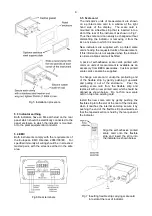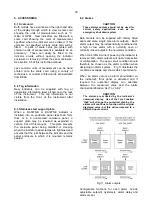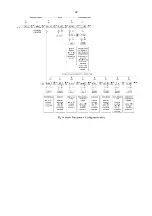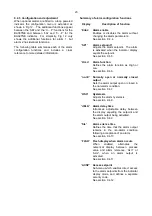
23
9.4.3 Configuration and adjustment
When optional alarms are fitted to a loop powered
indicator the configuration menu is extended as
shown in Fig 12. The additional functions appear
between the ‘SEt’ and the ‘C- - P’ functions for the
BA307NE and between ‘bAr’ and ‘C- -P’ for the
BA327NE indicator. For simplicity, Fig 12 only
shows the additional functions for alarm 1, but
alarm 2 has identical functions.
The following table summaries each of the alarm
configuration functions and includes a cross
reference to more detailed information.
Summary of alarm configuration functions
Display
Description of function
'EnbL’
Alarm enable
Enables or disables the alarm without
changing the alarm parameters.
See section 9.4.4
'SP1'
Alarm setpoint 1
Adjusts the alarm setpoint. The alarm
is activated when the indicator display
equals the setpoint.
See section 9.4.5
'Hi.Lo'
Alarm function
Defines the alarm function as High or
Low.
See section 9.4.6
'no.nC' Normally open or normally closed
output
Sets the alarm output open or closed in
the non-alarm condition.
See section 9.4.7
'HStr'
Hysteresis
Adjusts the alarm hysteresis.
See section 9.4.8
'dELA'
Alarm delay
time
Introduces adjustable delay between
the display equalling the setpoint and
the alarm output being activated.
See section 9.4.9
'SiL'
Alarm silence time
Defines the time that the alarm output
remains in the non-alarm condition
following acceptance of an alarm.
See section 9.4.10
‘FLSH’
Flash display when alarm occurs
When enabled, alternates the
numerical display between process
value and alarm reference, ‘ALr1’ or
‘ALr2’, when an alarm output is
activated.
See section 9.4.11
'ACSP' Access setpoint
Sub-menu which enables direct access
to the alarm setpoints from the indicator
display mode, and defines a separate
security code.
See section 9.4.12









































